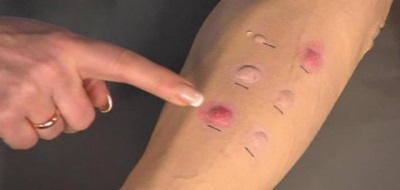Skin tests for allergens in children
Allergic diseases in children in our time are quite common. Their timely diagnosis with the help of allergoprob helps to alleviate the course of the disease, achieve recovery and prevent the development of severe forms of allergies.
What are allergy tests?
Allergic tests are called studies, during which the child determine the sensitivity to allergens. Also, such studies are called allergic diagnostics.
Indications
Allergy tests are prescribed for the child if he has:
- Food allergy;
- Atopic dermatitis;
- Bronchial asthma;
- Inflammatory diseases of the respiratory system;
- Pollinosis;
- Allergy to drugs.
Contraindications
Skin allergy tests do not hold:
- Under the age of 3 years;
- During the exacerbation of allergies (tests can be performed no earlier than 3-4 weeks after the last exacerbation);
- In acute infectious diseases;
- In primary immunodeficiency and exacerbations of autoimmune diseases;
- If in the past the baby had anaphylactic shock;
- If the child has severe somatic diseases with decompensation;
- After taking antihistamine drugs.
Types and methods of diagnosis
Skin tests are divided into:
- Scarification. Used to detect reactions to non-infectious (food, household, pollen, fungal and others) and infectious allergens.
- Prik-tests. The most common for identifying respiratory allergies.
- Intradermal. Most often used to detect reactions to infectious allergens.
- Cutaneous. Carried out with the use of applications (in case of suspected contact dermatitis) or drip method (with very high sensitization).
Cons compared with blood test
In the skin test, the child is in contact with allergens, so it can react to this type of research with an allergic reaction of varying severity, up to anaphylactic shock. That is why the implementation of skin allergy tests is carried out only in the conditions of medical institutions.

- Allergic skin tests can be performed only after 3-5 years. In addition, for this the child should not be aggravated. A blood test can be done at any age and even in the presence of exacerbation.
- Skin tests are more painful, and the study itself lasts longer.
- Using the skin test method, you can detect a reaction to 5–20 allergens, while a blood test allows you to evaluate the sensitization of a child’s body to more than 200 allergens.
Training
If a child takes antihistamines, they are canceled 5-7 days prior to skin tests. There are no other nuances of performing these analyzes, for example, the conditions to come for an examination on an empty stomach.
How do the analysis?
The test will depend on its type:
- If an application test is performed, the fabric with the allergen applied to it is applied to the skin of the child for 2 days. During this period, the fabric can not be wet.
- During the scratch test, the skin of the child is treated with drops of various allergens, then shallow scratches are made through them.
- The same technique of prick-test behavior, but instead of scratches, mini-shots are performed, the depth of which is up to 1 millimeter.
- With intradermal tests, allergens are injected into the skin of the child.
results
Scarification and prikatry estimate after 15-20 minutes after application of allergens on the skin. The presence of a reaction to an allergen is noted for swelling and redness. Further evaluation of the local reaction is carried out after another 24 hours and 48 hours Consider a positive test, during which there was a papule larger than 2 millimeters.
Evaluation of the skin test sample is carried out after two days by the presence of itching, redness and irritation in the place where the bandage was applied.





